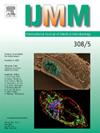SARS-CoV-2核衣壳蛋白延缓s期细胞周期
IF 3.6
3区 医学
Q1 MICROBIOLOGY
引用次数: 0
摘要
作为COVID-19病原体的严重急性呼吸综合征冠状病毒2型(SARS-CoV-2)的出现引发了前所未有的全球卫生危机。已证明SARS-CoV-2在感染的早期阶段特异性地干扰S期进展。核衣壳(N)是一种重要的结构蛋白。N的丰度和早期存在表明N蛋白可能在决定宿主细胞感染后的命运中起关键作用,包括细胞周期调节。我们的观察结果表明,SARS-CoV-2 N蛋白实际上是通过促进S期进入并同时阻断S期退出来诱导S期阻滞,这与以往报道的G1/S阻滞不同,其他报道描述的是G1和G2/M阻滞。细胞周期阻滞延长通常与细胞死亡有关,而我们的数据表明,N蛋白会抑制细胞增殖,减缓细胞生长,而不会主动触发细胞死亡。有趣的是,去除N臂、富sr区、CTD或c尾都会消除N蛋白抑制细胞生长的能力,而删除NTD不会影响这种能力,也不会影响S期阻滞。总而言之,sars - cov - 2n蛋白作为一个多功能参与者出现,不仅驱动病毒复制的关键方面,还通过调节细胞周期进程和生长对宿主细胞生理产生重大影响。本文章由计算机程序翻译,如有差异,请以英文原文为准。
SARS-CoV-2 nucleocapsid protein delays cell cycle in S-phase
The emergence of Severe Acute Respiratory Syndrome Coronavirus 2 (SARS-CoV-2) as the causative agent of COVID-19 precipitated a global health crisis of unprecedented scale. SARS-CoV-2 has been shown to interfere specifically with S phase progression during early stages of infection. Nucleocapsid (N) is an important structural protein. The abundance and early presence of N suggest that the N protein may play a pivotal role in determining the fate of host cells post-infection, including in cell cycle regulation. Our observations reveal that the SARS-CoV-2 N protein actually induces S phase arrest by promoting S phase entry and simultaneously blocking exit from this phase, which is different from previous report G1/S blockage, others describe G1 and G2/M arrest. Prolonged cell cycle arrest is frequently linked to cell death, while our data suggests the N protein curtails cell proliferation, slowing down cell growth without actively triggering cell death. Intriguingly, removing the N-arm, SR-rich region, CTD, or C-tail each abolishes the N protein’s ability to suppress cell growth, whereas deletion of the NTD does not impact this capability, nor does it affect S phase arrest. All told, the SARS-CoV-2 N protein emerges as a multifunctional actor, not only driving key aspects of viral replication but also exerting significant effects on host cell physiology by modulating cell cycle progression and growth.
求助全文
通过发布文献求助,成功后即可免费获取论文全文。
去求助
来源期刊
CiteScore
9.70
自引率
0.00%
发文量
18
审稿时长
45 days
期刊介绍:
Pathogen genome sequencing projects have provided a wealth of data that need to be set in context to pathogenicity and the outcome of infections. In addition, the interplay between a pathogen and its host cell has become increasingly important to understand and interfere with diseases caused by microbial pathogens. IJMM meets these needs by focussing on genome and proteome analyses, studies dealing with the molecular mechanisms of pathogenicity and the evolution of pathogenic agents, the interactions between pathogens and host cells ("cellular microbiology"), and molecular epidemiology. To help the reader keeping up with the rapidly evolving new findings in the field of medical microbiology, IJMM publishes original articles, case studies and topical, state-of-the-art mini-reviews in a well balanced fashion. All articles are strictly peer-reviewed. Important topics are reinforced by 2 special issues per year dedicated to a particular theme. Finally, at irregular intervals, current opinions on recent or future developments in medical microbiology are presented in an editorial section.

 求助内容:
求助内容: 应助结果提醒方式:
应助结果提醒方式:


